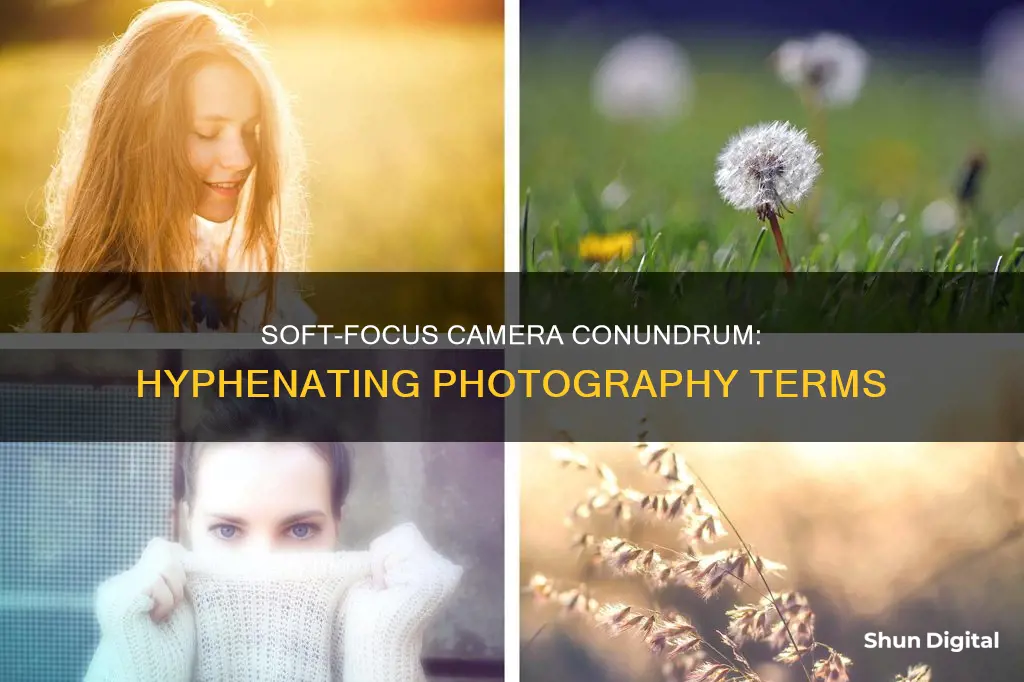
Soft focus is a photography technique that blurs the edges of an image, creating a dreamy, ethereal quality. It is often used in portraiture, landscape, and still life photography to capture fleeting moments of introspection or joy, transform regular scenes into mystic expanses, and elevate everyday objects into subjects of profound beauty. Soft focus shots require special filters or lenses to achieve this look and can also be done by applying Vaseline to the lens or stretching nylon across the front lens element. This technique is particularly useful for adding a dreamy glow to glamour shots in portraits, as it allows for the blending of tones and eliminates any fine details on the skin or face.
What You'll Learn

Soft focus is a deliberate technique
The soft focus effect is not the same as simply blurring an image. It is caused by a lens flaw, specifically spherical aberration, where the lens forms blurred images due to the diffusion of light. This aberration occurs when incoming rays of light focus at different points after passing through a spherical lens, resulting in an improper convergence of light. A soft focus lens deliberately introduces spherical aberration to create the desired effect while retaining sharp edges.
There are several ways to achieve the soft focus effect. One method is to use a specialist soft focus lens, such as the Petzval portrait lens or the Aero Ektar lens. These lenses are designed to introduce spherical aberration and allow control over the degree of softness in the image. Another way to create soft focus is by using filters, such as soft, diffusion, or Hollywood filters, which are placed in front of the camera lens to diffuse the light.
For those on a budget, there are DIY techniques to achieve soft focus. One method is to stretch a nylon stocking or pantyhose over the front of the lens, creating a soft lens filter. This can be secured with a rubber band, and the amount of stretch can be adjusted to control the softness of the effect. Another DIY technique involves smearing a small amount of Vaseline or petroleum jelly on a clear filter attached to the front of the lens. This diffuses the light and creates the soft focus effect.
Soft focus has been used in photography and cinematography for many years, particularly in older films and Hollywood productions from the 1950s. It was often used to film female actresses, giving them a flattering, dreamy glow. Today, soft focus remains a popular aesthetic choice, adding a unique and artistic touch to photographs and films.
Understanding Aperture Priority Mode in Photography
You may want to see also

Soft focus is not the same as blurring
A soft focus lens deliberately introduces spherical aberration, which blurs fine textures in the image while retaining sharp edges across areas of high contrast. This is not the same as an out-of-focus image, and the effect cannot be achieved simply by defocusing a sharp lens. Soft focus is a style of photograph produced by such a lens, which has been described as "an image that is in focus but has a halo of out-of-focus images around it."
The soft focus effect is often used in glamour photography, as it eliminates blemishes and gives the subject a dreamy, ethereal glow. It is also used in portrait photography to subdue shadows and imperfections on a person's face. The effect can be achieved through the use of a soft focus lens, a soft focus filter, or DIY techniques such as using Vaseline or a stocking over the lens.
While blurring can be an attractive feature in photography, creating a soft focus image requires more precision and intentionality. By understanding the difference between soft focus and blurring, photographers can become more intentional in their craft and create unique and aesthetically pleasing shots.
Exporting Camera Raw Presets: A Step-by-Step Guide
You may want to see also

Soft focus is achieved through spherical aberration
Soft focus is a lens flaw in photography, where the lens forms images that are blurred due to uncorrected spherical aberration. Spherical aberration is a type of aberration found in optical systems with elements that have spherical surfaces, such as lenses and curved mirrors. This aberration occurs because light rays that strike a spherical surface off-centre are refracted or reflected more or less than those that strike close to the centre. This deviation results in a reduction of image quality.
In the context of soft focus, spherical aberration is deliberately introduced to blur fine textures in the image while retaining sharp edges in areas of high contrast. This effect is often described as a dream-like or romantic aesthetic and is particularly popular in glamour photography as it eliminates blemishes. It is not the same as an out-of-focus image, and simply defocusing a sharp lens will not achieve the same result.
The first deliberate use of soft focus with undercorrected spherical aberration is thought to have originated with French pictorialists around 1900. This technique then spread to the United States, where these lenses were most popular between 1910 and 1930. Notable photographers who have utilised soft focus in their work include Julia Margaret Cameron, Bob Guccione, and early Edward Weston.
To achieve soft focus through spherical aberration, photographers can use specialised soft focus lenses or filters. Alternatively, DIY techniques can be employed, such as stretching nylon stockings over the lens or applying a thin layer of petroleum jelly on a clear filter.
iPad2 Camera Auto-Focus: Yes or No?
You may want to see also

Soft focus is used in various photography genres
Soft focus is a photography technique that adds a subtle blur to an image, giving it a dreamy, ethereal quality. It is achieved by deliberately introducing spherical aberration, which blurs fine textures in the image while retaining sharp edges in areas of high contrast. Soft focus is not the same as an out-of-focus image, as it involves diffusing light rather than simply defocusing a sharp lens. This effect is often achieved using soft focus lenses or filters, but can also be created through DIY methods or post-processing techniques.
Soft focus is commonly used in portrait photography, as it can flatter the subject's complexion by eliminating blemishes and fine details. It has been used in Hollywood since the 1910s to create a dreamy, romantic look for actresses. However, soft focus is also versatile and can be used in a variety of photography genres to create different moods and atmospheres.
In landscape photography, soft focus can transform a regular scene into a mystical expanse, making it seem like something out of a fairy tale or storybook. It can blur the harsh lines of reality, lending a dream-like quality to images of hills, rivers, and trees. Similarly, in still life photography, soft focus can elevate everyday objects into subjects of profound beauty by emphasising texture and form in a dance of light and shadow.
Photographers can also use soft focus to set the mood of an image or highlight the main subject. By adding a dreamy or nostalgic look to an image, soft focus can evoke old memories or romantic moments. It can also draw attention to the main subject by slightly blurring the surrounding area, making the clearest part of the image stand out.
Overall, soft focus is a powerful tool for artistic expression in photography, allowing photographers to create evocative and nostalgic images that linger in the viewer's mind.
Cleaning Camera Battery Compartments: Removing Corrosion
You may want to see also

Soft focus can be achieved in different ways
Soft Focus Lenses:
Specialised soft focus lenses can be purchased, such as the Petzval portrait lens, Aero Ektar, or Dallmeyer Bergheim. These lenses deliberately introduce spherical aberration, blurring fine textures while retaining sharp edges.
Soft Focus Filters:
Soft focus filters are placed in front of the camera lens to reduce local contrast and add a dreamy glow to the image. They are available from various manufacturers, such as Lee Soft Filters, Cokin, and Hoya, and can be screw-in or square types.
DIY Soft Focus Techniques:
You can create your own soft focus effect by stretching a nylon stocking or pantyhose over the front of the lens and securing it with a rubber band. The tightness of the stretch will determine the strength of the effect. Alternatively, you can smear a small amount of Vaseline on a clear or UV filter attached to the front of your lens. This technique allows for more precise control over the area of the frame that will have the softening effect.
Post-Processing:
Soft focus effects can also be achieved through digital manipulation or editing software such as Photoshop. One method is to duplicate the image layer, apply a surface blur, and then adjust the filter settings. Another approach is to use the Gaussian blur or Gaussian smoothing filter and adjust the opacity and blending mode.
Adjusting Your Logitech Camera to Disable Auto Focus
You may want to see also
Frequently asked questions
Soft focus is a technique used to capture images that reduce the contrast of fine detail in the image. It creates a dreamy, ethereal quality reminiscent of memories or dreams.
Soft focus can be achieved by using a soft focus lens, which deliberately uses spherical aberration to blur the image. It can also be done using soft focus filters, DIY tricks such as applying Vaseline to a UV filter, or through post-processing techniques.
While both techniques create a blur, soft focus affects the entire image, creating a "soft" blur or glow around the subject. Shallow focus, on the other hand, refers to a shallow depth of field where the area around the subject is generally not as sharp.
Some examples of soft focus lenses include the Canon EF f/2.8 w/ Softfocus lens, Petzval portrait lens, Aero Ektar lens, and the Kodak Portrait.
Soft focus is commonly used in portrait photography to capture human emotions and create a flattering look. It is also used in landscape photography to create a mystical atmosphere and in still life photography to elevate everyday objects.







